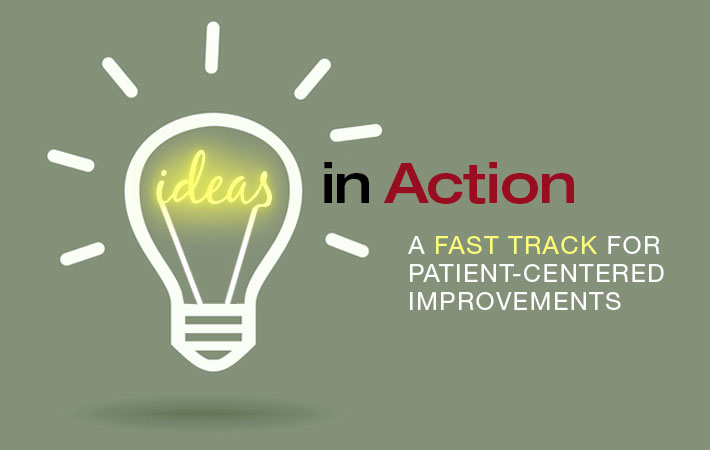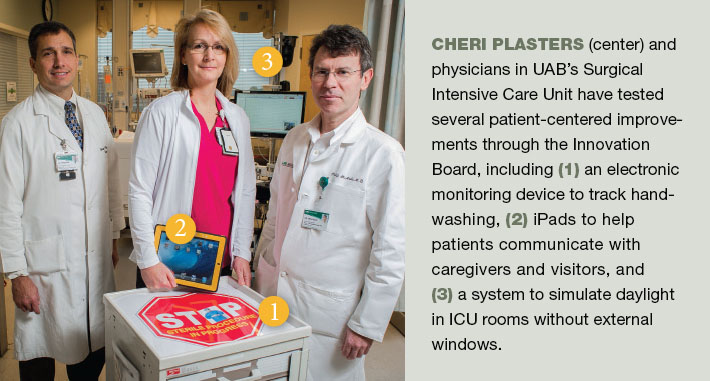
By Gail Allyn Short
Cheri Plasters, B.S.N., had a great idea. The UAB Hospital Surgical Intensive Care Unit (SICU) nurse wanted a better way to teach first-year medical residents how to insert catheters known as central venous lines, which are critical for administering medications to seriously ill patients.
Plasters wanted to capture the proper procedure in a video, which could then be shown to residents and other new staff. So she took her idea to the UAB Health System’s Innovation Board, which offers support and seed funding for high-potential projects. Plasters came away with pilot funding and a new contact: film instructor Michele Forman, M.F.A., who directs the Media Studies Program in UAB’s College of Arts and Sciences.
“Michele lent me a camera and tripod, and her students have captured some of the video,” Plasters says. “The wonderful thing about the Innovation Board is they help you make the connections you need to get quality improvements started.”
Investing in Success
The Innovation Board was formed in 2011 as part of AMC21, the Health System’s strategic plan to become the preferred academic medical center for the 21st century. The board’s mission “is to take the risk out of trying new things,” says director Melissa Mancini, who is also the Health System’s director of strategy and business development. The Innovation Board issues small grants to support ideas that can be implemented, tested, and evaluated in a short period of time, Mancini explains. Once a pilot project is complete, typically within 90 days, teams report back to the board with their results, she says. The board has funded about half of the more than 70 ideas submitted through fall 2013.
Several successful projects have already passed into regular use in the Health System, including a smartphone-friendly app developed by UAB’s worker’s compensation team, which allows outside companies that contract with UAB to quickly fill out required forms after an injury, expediting patient care. “Once we see that an idea works, we can scale it up throughout the organization,” Mancini says. “And if it doesn’t work, we analyze what we’ve learned.”

Sign Language
Kellie Flood, M.D., medical director of the Acute Care for Elders Unit at UAB Highlands Hospital, wanted a better way for staff to communicate the functional and cognitive status of the unit’s patients, especially during shift changes.
Inspired by a Canadian hospital’s system, and armed with an Innovation Board grant, Flood’s team created a system of pictograms using whiteboards and magnets in each patient room. A spoon beside the word “assist” indicates that a patient needs help eating, for example. “The idea is that you walk into a room, glance at the patient’s whiteboard, and immediately know the patient’s status,” says Flood.
Support from the Innovation Board lets anyone with a great idea—whether their own or one they’ve seen succeed elsewhere—acquire the means “to actually test it out,” Flood says. “You don’t have to talk to 10 different people to make it happen.”
Healing Touch
Jessica Merlin, M.D., M.B.A., who directs the palliative medicine program at UAB’s 1917 Clinic, is using an Innovation Board grant to help patients with HIV/AIDS cope with chronic pain. Many of these patients would benefit from physical therapy, an evidence-based approach for treating chronic pain, Merlin explains. But financial difficulties, transportation issues, and other logistical challenges often kept patients from completing appointments at an off-site physical therapist.
At the suggestion of Rodney Tucker, M.D., director of UAB’s Center for Palliative and Supportive Care, Merlin applied for an Innovation Board grant in 2012 to bring a physical therapist to her clinic for a few hours a week. The therapist “can talk with the patients about the issue that’s triggering their pain and describe for them in detail what she’ll do,” Merlin says. The therapist does manual therapy (similar to massage) and also teaches patients about balance, posture, and strengthening.
Patients report having less pain after their physical therapy sessions, says Merlin. The program is now cost-neutral, and is continuing into the future, she notes. Sometimes, all that’s needed to make a big difference, she says, “is just a little bit of start-up money.”